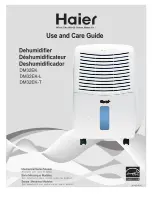
2
corresponds to the mains voltage;
- The mains supply is compatible with the appliance's electricity needs and is
correctly grounded.
•
In the event of abnormal operation or the release of odours from the appliance,
turn it off immediately, unplug it from its power supply and contact a professional.
• Before servicing or performing maintenance on the appliance, check that it is
powered off and completely disconnected from the power supply. Moreover,
check that the heating priority (where applicable) is deactivated and that any
other device or accessory connected to the appliance is also disconnected from
the power supply.
• Do not disconnect and reconnect the appliance to the power supply when in
operation.
• Do not pull on the power cord to disconnect it from the power supply.
• If the power cord is damaged, it must be replaced by the manufacturer, an
authorised representative or a repair facility only
.
•
Do not perform maintenance or servicing operations on the appliance with wet
hands or if the appliance is wet.
•
Before connecting the appliance to the power supply, check that the connection
unit or socket to which the appliance will be connected is in good condition and
shows no signs of damage or rust.
•
For any component or sub-assembly containing a battery: do not recharge or
dismantle the battery, or throw it into a fire. Do not expose it to high temperatures
or direct sunlight.
• In stormy weather, disconnect the appliance from the power supply to prevent it
from suffering lightning damage.
•
Do not immerse the appliance in water (with the exception of cleaners) or mud.
WARNINGS CONCERNING APPLIANCES CONTAINING R410A REFRIGERANT
•
Do not discharge R410A fluid into the atmosphere. This is a fluorinated greenhouse
gas, covered by the Kyoto Protocol, with a Global Warming Potential (GWP) = 2088
(European regulation EU 517/2014).
•
In order to comply with the applicable standards and regulations in terms of the
environment and installation, in particular Decree No. 2015-1790 and/or European
regulation EU 517/2014, a leak test must be performed on the cooling circuit when
the appliance is first started and at least once a year. This operation must be carried
out by a specialist certified to test cooling appliances.
INSTALLATION AND MAINTENANCE
•
The appliance may not be installed close to combustible materials, or the air duct
inlet of an adjacent building.
•
With some appliances, it is essential to fit a "protection grid"-type accessory if the
unit is installed in an area with uncontrolled access.
•
During installation, troubleshooting and maintenance, pipes may not be used as
steps: the pipe could break under the weight, spilling coolant and possibly causing
serious burns.
•
When servicing the appliance, the composition and state of the heat transfer fluid
must be checked, as well as the absence of any traces of coolant.
•
During the appliance's annual sealing test in accordance with applicable legislation,
the high and low pressure switches must be checked to ensure that they are
securely fastened to the cooling circuit and that they cut off the electrical circuit
when tripped.
• During maintenance work, ensure there are no traces of corrosion or oil around
the cooling components.
• Before beginning work on the cooling circuit, stop the appliance and wait for a few
minutes before fitting the temperature and pressure sensors. Some elements such
as the compressor and piping may reach temperatures in excess of 100°C and high
pressures with the consequent risk of severe burns.
TROUBLESHOOTING
•
All brazing must be carried out by qualified brazers.
• Replacement pipes must always be made of copper in compliance with standard
NF EN 12735-1.
EN
Содержание SIROCCO 2 2M
Страница 12: ...11 2 4 I Access to the electrical connection terminal boards...
Страница 28: ...27 5 4 I Wiring diagrams 5 4 1 SIROCCO2 2M...
Страница 29: ...28 5 4 2 SIROCCO2 3M 5M EN...
Страница 30: ...29 5 4 3 SIROCCO2 5T...




































